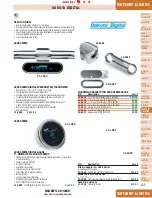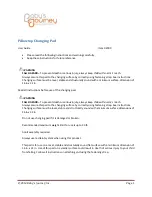
One of the most common and productive
means to track conveyor belting is to skew roll-
ers. Excess skewing of rollers, which may cause
belt to bow and may force belt to rub on side
frame causing belt damage, usually will not
completely solve belt tracking problems
ONLY trained personnel should make belt
tracking adjustments. Shut unit “OFF” and
lock out power source before attempting
adjustments in belt tracking.
To adjust return rollers, simply loosen attach-
ment bolt that secures bracket to the side of
the conveyor (see illustration above). Move
bracket to skew return roller assemblies (as
noted in Advanced Tracking Adjustments later
in manual). Remember to make adjustments in
SMALL increments.
When adjustment is complete, tighten bolt
firmly securing return roller bracket to the side
of the conveyor.
When adjustments noted in section above
have been completed and belt continues to
track erratically, a second series of tracking
adjustments are necessary.
First, determine the infeed and discharge ends
of the conveyor. The following adjustments
will be made with the infeed end as the refer-
ence point.
If belt tracks toward side “R” (see illustration
above), skew return rollers in direction “B” to
shift belting toward side “L”. If belt tracks
toward side “L”, skew return rollers in direc-
tion “A” to shift belting toward side “R”.
Skewing head pulley (pulley at unit discharge)
in direction “A” moves belt toward side “L”.
Skewing head pulley in direction “B” moves
belt toward side “R”.
As a rule of thumb, do not use drive and
take-up pulley for belt tracking since this will
overly increase belt tension. When adjusting
take-up pulley, adjust both sides an equal
amount.
As a last resort, shift the tail pulley in
direction “B” to move belting toward side “L”;
shift head pulley in direction “A” to move
belting toward side “L”.
Improper tracking of conveyor belting should
be considered a “systems” problem rather than
solely a deficiency in the belt. To explain, a belt
is tracked with adjustments made in the system or
entire conveyor rather than just the belting.
Upon start-up, if belt tracks to one side of
unit, turn unit “OFF”, lock out power source
and confirm that conveyor is square. All
prime tracking components must be square
with bed including drive pulley, tail pulley,
snub roller and return rollers.
Both sides of
take-up should be adjusted exactly the same
amount. The conveyor should be level across
the width of the unit. Confirm that the belt has
been properly threaded (see “Belt Path” section)
and that belt lacing is square with the belt edges.
Make adjustments as necessary; however, all
adjustments should be made in small increments.
Start conveyor again and operate for at least
ten minutes once initial phase of adjustments are
complete. If belt continues to track erratically, turn
unit “OFF” before belt is allowed to run so far off
center that it rubs side of conveyor.
BELT TRACKING
GENERAL INFORMATION
10
Upon initial use the belting will stretch after
a few days of operation. Remember that
maintaining proper belt tension is a crucial
element in belt tracking.
Therefore, this stretch-
ing of a belt when placed into operation may affect
its ability to track. Adjustment of the take-up pulley
will likely adequately compensate for initial stretch.
However, depending on the overall unit length,
removal of a belt patch may be necessary to correct.
ONLY trained personnel should make belt
tracking adjustments.
Belt must be tracked in both unloaded and loaded
situations. The return direction of the belt must
clear supports, ceiling hangers, floor openings,
etc. Dragging on such components will contribute
to belt tracking problems and is certain to damage
belting at extended intervals.
In a reversible application, a belt that runs off to
one side in one direction will likely run off to the
other side when operated in the opposite direc-
tion. Do not allow belt to rub against side of con-
veyor frame, which will surely damage belt.
SKEWING RETURN ROLLERS
ERRATIC TRACKING AT START-UP
ADVANCED TRACKING ADJUSTMENTS
Содержание 450BOS
Страница 1: ...Installing and Maintaining Your Roach Conveyor...
Страница 17: ...MODEL 725TB END DRIVE END side mount DRIVE center drive drawings 17...
Страница 26: ...MODEL 796RB END DRIVE END side mount DRIVE center drive drawings 26...
Страница 29: ...MODEL 751RB END DRIVE END side mount DRIVE center drive drawings 29...











































